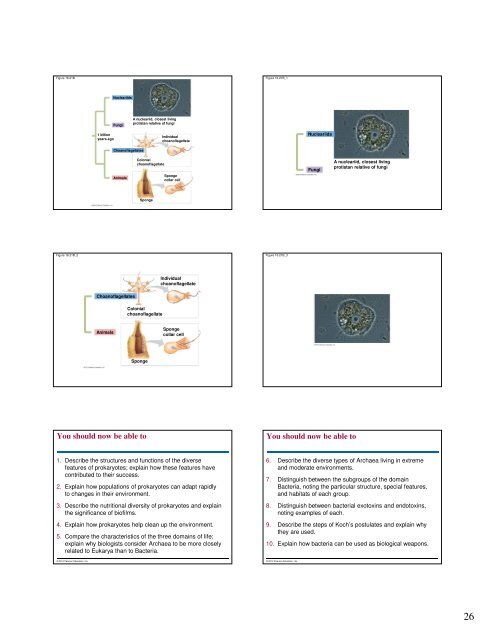Microbial Life: Prokaryotes and Protists - Renz Science
Microbial Life: Prokaryotes and Protists - Renz Science
Microbial Life: Prokaryotes and Protists - Renz Science
Create successful ePaper yourself
Turn your PDF publications into a flip-book with our unique Google optimized e-Paper software.
Figure 16.21BFigure 16.21B_1Nucleariids1 billionyears agoFungiA nucleariid, closest livingprotistan relative of fungiIndividualchoanoflagellateNucleariidsChoanoflagellatesAnimalsColonialchoanoflagellateSpongecollar cellFungiA nucleariid, closest livingprotistan relative of fungiSpongeFigure 16.21B_2Figure 16.21B_3IndividualchoanoflagellateChoanoflagellatesColonialchoanoflagellateAnimalsSpongecollar cellSpongeYou should now be able toYou should now be able to1. Describe the structures <strong>and</strong> functions of the diversefeatures of prokaryotes; explain how these features havecontributed to their success.2. Explain how populations of prokaryotes can adapt rapidlyto changes in their environment.3. Describe the nutritional diversity of prokaryotes <strong>and</strong> explainthe significance of biofilms.4. Explain how prokaryotes help clean up the environment.5. Compare the characteristics of the three domains of life;explain why biologists consider Archaea to be more closelyrelated to Eukarya than to Bacteria.6. Describe the diverse types of Archaea living in extreme<strong>and</strong> moderate environments.7. Distinguish between the subgroups of the domainBacteria, noting the particular structure, special features,<strong>and</strong> habitats of each group.8. Distinguish between bacterial exotoxins <strong>and</strong> endotoxins,noting examples of each.9. Describe the steps of Koch’s postulates <strong>and</strong> explain whythey are used.10. Explain how bacteria can be used as biological weapons.© 2012 Pearson Education, Inc.© 2012 Pearson Education, Inc.26


